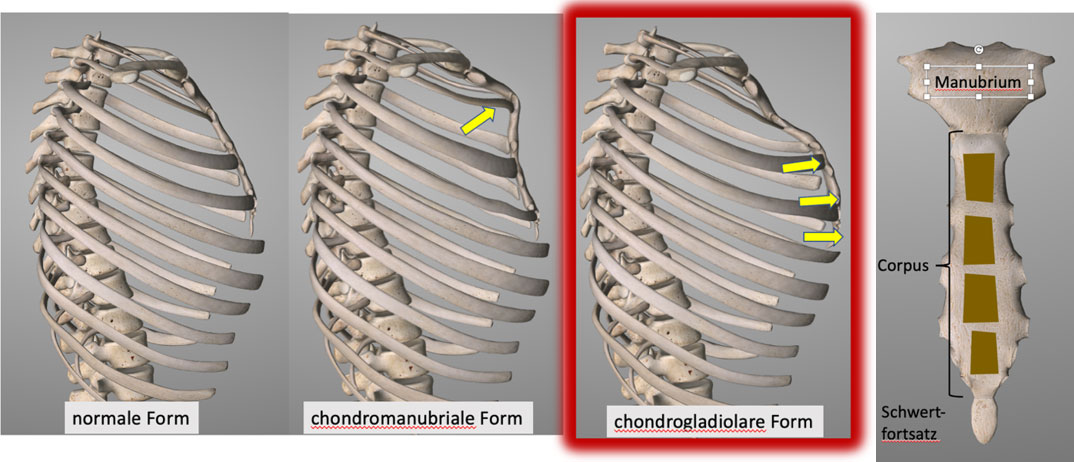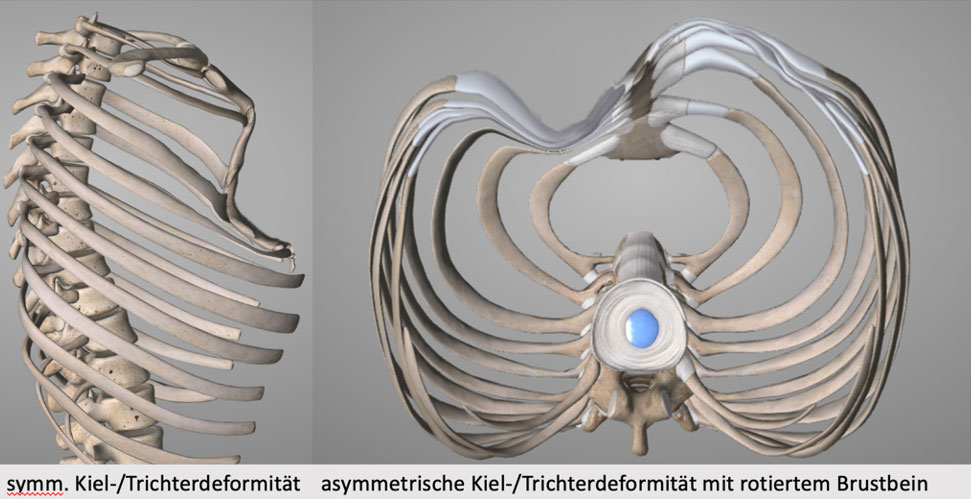Pigeon breast (pectus carinatum)
Compared to funnel chest, keel chest is one of the rarer thoracic deformities. In this case, the sternum curves abnormally over the surface of the thorax. The sternum consists of two parts, the manubrium and the corpus (o. gladiolus). If the manubrium part is protruding, it is called a "chondromanubrial form", if the body of the sternum is abnormally raised, it is called a "chondrogladiolar form".
The keel chest develops later than the funnel chest and is particularly noticeable during growth in puberty. As with the funnel chest, boys are affected 4 times as often as girls. By far the most common "chondrogladiolar form" is found in 95% of patients with keel breasts (marked in red).
The deformities have in common an increased growth of the cartilaginous rib parts. The problem seems to focus on the statics and flexibility of the sternum. The sternum has a cartilaginous - connective tissue connection between the manubrium and the corpus, which, in contrast to the soft connections between the bone nuclei of the corpus, does not close even in adults. The nuclei of the sternum fuse together at the end of growth (around the age of 18). This is called natural ossification. A sternum that is too soft and too stiff (ossification times) means altered statics and altered - namely too low internal pressure conditions in movement (breathing etc.) and leads to growth in the adjacent rib cartilages through the production and deposition of cartilage intercellular substance. This leads to rib cartilage lengthening. The latter is also clearly visible intraoperatively during rib cartilage resections.
Apart from the altered statics and flexibility of the sternum, keel deformities are described in connective tissue diseases such as Marfan syndrome, Ehlers-Danlos syndrome or the rare mucopolysaccharidoses (storage diseases of interstitial substance).
The keel deformity can also occur together with a funnel chest (so-called horizontally oriented/symmetrical keel funnel deformity), with the protrusion in the manubrium area and the funnel in the corpus area of the sternum (see Curraino-Silverman syndrome). Asymmetrical keel deformities are confined to one half of the body in vertical alignment. Here, a vertical twisting of the sternum may occur so that a depression occurs on the adjacent - opposite - half of the body (asymmetrical keel-funnel deformity).

In the case of a simple symmetrical pigeon breast without a combined funnel or groove formation, the cosmetic aspect is in the foreground, in addition to the periosteal/perichondral stretching and touching pain, and is perceived as a very psychologically stressful impairment with a reduction in the quality of life. In addition, there is also the unpleasant feeling to the point of pain when lying on the stomach on a hard surface. Cardiac output and breathing mechanics are usually not pathologically impaired.
However, in the case of a keel funnel deformity, pressure can be exerted on the organs in the chest (heart, lungs). The cause of this is the depression, i.e. the simultaneous pressure exerting and displacing funnel formation. The sometimes expressed opinion that thoracic deformities would grow or be "related to inadequate nutrition" (Vit.D etc.) is incorrect.
Therapy:
The pigeon breast can be treated conservatively with a girdle/pelotte/corset. This involves applying long-term pressure to the atypically bulging chest wall. The compression treatment must be applied prebuertary (11-13a) daily for many hours (10-20h Kang et.al.) and the success unfortunately depends largely on the patient's compliance (toleration of the procedure).
As a rule, surgical correction will be necessary, especially for higher-grade forms. The procedure according to Abramson (2005), where a steel bracket is implanted to lower the sternum due to pressure, has not been able to establish itself as the "state of the art procedure" universally in the surgical world.
The "golden standard" remains the endo-perichondral resection of the overgrown rib cartilage, the horizontal sternal notch (partial slit osteotomy) and the tightening of the remaining (!) perichondrium tubes (Ravitch/Welsh). Here, no steel implant with additional steel plates is used, which may have to be screwed and wired. However, it is essential to choose the time of surgery late postpubertally, when the growth processes are coming to an end. The timing can be determined by the degree of fusion of the bone nuclei in the sternum.

The complete healing phase is about 1-2 months until all usual sports should be possible again - after medical control.



